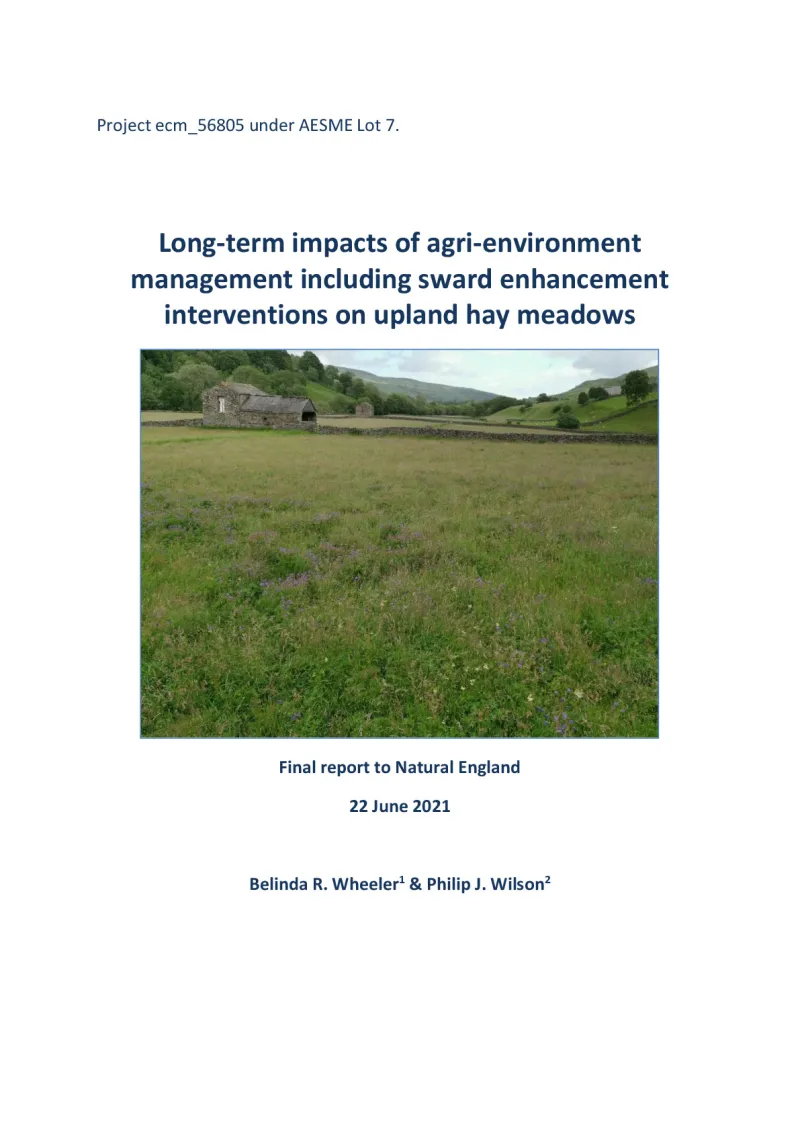Impacts of agri-environment management including sward enhancement interventions on upland hay meadows
The report provides an updated assessment of the UK's Agri-Environment Schemes' (AES) impact on upland hay meadows.
- Other
- 2014-2022
- Environmental impacts


This study is part of the UK framework for the delivery of environmental stewardship monitoring and evaluation. The outputs of this project will contribute to regular reports supporting the Rural Development Programme (RDP) monitoring framework.
The study covers the 2019-2020 evaluation period and was commissioned by Natural England.
The main objective of this project was to provide an updated assessment of the impact of AES on upland hay meadow (UHM) by resurveying the condition of UHM farms in a core sample of sites currently managed under higher level stewardship (HLS) or countryside stewardship (CS), which has existing data from 2012 and earlier. In addition, the report looked at a sample of meadows with sward enhancement interventions by introducing plant material (e.g. green hay, seed or plug plants).
The 103 sites selected by Natural England formed the core sample for the 2020 field survey. The aim was to resurvey each site to determine its current condition, explore differences between the 'HK6' (maintenance of species-rich semi-natural grassland) and 'HK7' (restoration of species-rich semi-natural grassland) samples, and further identify any changes. To provide a control group of sites to compare the condition and performance over time of the sites within agri-environment management, 20 extra sites were selected.
The evaluation concluded, among other things, that UHM communities encountered within the survey sample were not of the highest quality. 'MG3' (Anthoxanthum odoratum-Geranium sylvaticum grassland), the typical community of drier meadows, was found in 25% of the core sample of farms in 2020, and the wetter 'MG8' (Cynosurus cristatus-Caltha palustris grassland) grassland in 33% of farms. Typical positive indicator associates of MG3 were missing from many farms. MG8 farms were the most diverse across the sample, but richness was lower within individual sites. A greater proportion of the farms had closest affinities with 'MG6b' (Anthoxanthum odoratum sub-community). These varied widely in species richness and many farms are likely to be degraded farms of MG3 or MG8. The sward enhancement sample meadows were predominantly MG6b (82%) and the non-agreement control sample was dominated by poorer grassland, although a few farms of MG3 and MG8 were found.
In addition, only 45% of the UHM farms in core sample sites were in favourable conditions, with G09 UHM priority habitat grassland, 34% unfavourable conditions and 19% not being a priority grassland type.
Regarding the core sample of 95 sites, 69% of the already supported farms of species-rich priority grassland in favourable condition in 2012 had maintained this status in 2020, while the rest declined. Farms within sites that exited the ESA scheme declined in condition, and over 50% of them were no longer managed as meadows in 2020. Instead, they were managed as permanent sheep pastures.
Furthermore, the length of time since the start of agri-environment management had a significant effect on vegetation composition. Across all sites, the number of species recorded across all quadrats per site, the number of positive indicator species across all quadrats per site and the mean number of species per quadrat all declined from 1987 to 2020. These declines were, however, different under the management options studied and did not follow a consistent trajectory through time. The number of species per quadrat within the sample increased from 1987 to 1995. Between 1995 and 2002, however, numbers significantly declined until 2020, although this differed between options. The number of positive indicator species declined in fields not managed under an AES but remained relatively stable where fields were under scheme management, increasing slightly but not significantly between 2002-2012 and 2020, where swards were enhanced.
Lastly, upland hay meadows were already suffering biodiversity loss at the time of entry into the ESA scheme in the 1980s due to agricultural intensification since the 1940s. Although ESA management resulted in early successes, some major changes happened in farming systems in the northern English uplands between 1995 and 2002, further affecting hay meadows' ecology. The potential impact of changes in grazing stock, cutting regimes, temperature, rainfall and the possible impact of atmospheric nitrogen deposition are discussed in relation to changes in the composition and condition of upland hay meadows. Scheme management may have had a positive impact in slowing but not halting deterioration.
Author(s)
Natural England